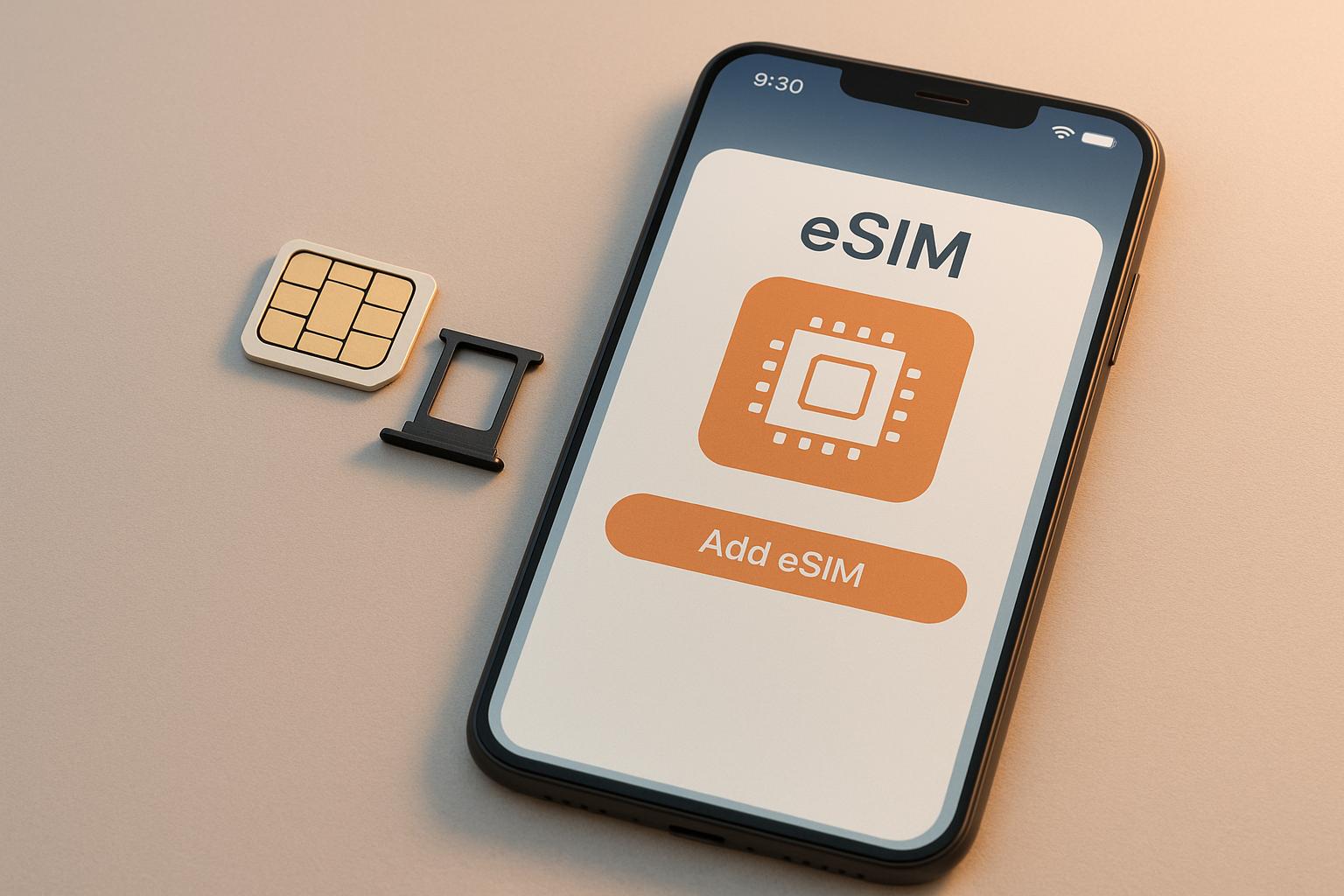5 Pros and Cons of eSIM vs SIM Cards
https://www.zimconnections.com/5-pros-and-cons-of-esim-vs-sim-cards/
 SHARE
SHARE
Ever wondered whether to stick with a SIM card or switch to an eSIM? Here’s the quick answer: eSIMs are built directly into your device, offering remote activation, multiple profiles, and extra security. On the other hand, SIM cards are physical, easy to swap between devices, and compatible with almost all phones.
Key Takeaways:
- eSIM Pros: Easy remote setup, multiple plans, better security, hassle-free for travel, and saves space in devices.
- eSIM Cons: Limited device and carrier support, internet needed for activation.
- SIM Card Pros: Universally compatible, simple to switch devices, easily replaceable, and no internet required to activate.
- SIM Card Cons: Can be lost or damaged, difficult for frequent travellers, and limited to one network at a time.
Quick Comparison Table:
| Feature | eSIM | SIM Card |
|---|---|---|
| Setup | Remote activation via QR code | Physical insertion required |
| Device Compatibility | Limited to newer models | Works with almost all devices |
| Travel | Activate plans before arriving | Requires buying local SIM abroad |
| Security | Built-in, harder to lose | Can be lost or stolen |
| Network Switching | Multiple profiles stored digitally | One network per SIM at a time |
Choosing between them depends on your device, travel habits, and whether you prefer physical or digital solutions. If your phone supports eSIMs, they’re ideal for convenience and flexibility. Otherwise, SIM cards remain a reliable option for most users.
eSIM vs Physical SIM: Pros and Cons You Need to Know! 📱
5 Advantages of eSIMs
eSIM technology brings a range of benefits for travellers and businesses looking for flexible and dependable connectivity.
1. Easy Remote Setup
With eSIMs, setup is a breeze. There’s no need to fiddle with physical SIM cards or make trips to a shop. You can activate an eSIM by simply downloading a profile or scanning a QR code, and your device configures itself in just a few minutes.
"Instead of juggling physical cards, eSIM lets you manage all your connections remotely. It’s like swapping your old CDs for a playlist – instant, digital, flexible and hassle-free." – Cradlepoint.com
For businesses, this remote provisioning translates to major time savings. Instead of dispatching technicians for installations, network updates and carrier changes can be handled in minutes, saving countless hours annually.
2. Store Multiple Plans
Modern eSIM-enabled phones can store between 5 and 10 profiles, with the option to keep one or two active at a time. This makes it easy to separate work and personal profiles or maintain local plans for different countries. Switching between profiles is as simple as navigating through your device’s settings and tapping a few options.
3. Enhanced Security
eSIMs don’t just make life easier – they also add a layer of security. Since they’re embedded directly into your device, there’s no risk of losing or misplacing a physical SIM card. If your device is stolen, you can deactivate the eSIM remotely, preventing unauthorised use. Plus, eSIMs reduce risks like SIM cloning and tampering, making them a safer option overall.
4. Simplified International Travel
Travelling abroad? eSIMs make staying connected effortless. You can activate local or global plans digitally before your trip, skipping the hassle of finding a SIM card shop or dealing with high roaming fees. Providers like ZIM Connections offer coverage in over 200 destinations, letting you purchase and activate plans for seamless connectivity across multiple countries.
For instance, you could set up a local plan for France while still in the UK, ensuring you’re connected the moment you arrive.
5. Saves Space in Devices
By eliminating the need for SIM card slots and trays, eSIMs free up valuable space inside devices. This allows manufacturers to include larger batteries, add new features, or design slimmer, more compact devices – all without sacrificing connectivity. It’s a small change with big implications for device design and functionality.
Disadvantages of eSIMs
While eSIM technology brings convenience, it does come with some hurdles, particularly when it comes to compatibility with devices and carriers.
Limited Support from Carriers and Devices
A significant drawback of eSIMs is that many older or lower-cost devices don’t include the necessary eSIM chip, making activation impossible even if a carrier supports it. For example, certain regional models, like iPhones sold in mainland China, prioritise dual physical SIM slots over eSIM functionality. On top of that, some mobile networks, especially in countries like the US and Australia, restrict eSIM activation to specific, approved devices.
Another barrier arises with carrier-locked devices. If a phone is locked due to financing agreements, its eSIM capabilities may remain restricted until those obligations are met.
These limitations underscore the importance of checking both device and carrier compatibility before opting for an eSIM over a traditional SIM card.
SIM Card Advantages and Disadvantages
While eSIMs bring a modern, digital approach to connectivity, traditional SIM cards remain a reliable and widely accepted option. They offer ease of use, broad compatibility, and straightforward replacement, though they come with certain limitations when compared to their digital counterpart.
Why SIM Cards Are Good
One of the biggest strengths of physical SIM cards is their universal compatibility. Almost every mobile device – whether it’s a simple feature phone or the latest high-end smartphone – comes with a SIM card slot. This means you can switch between devices with ease, without worrying about whether your SIM will work.
Another benefit is the ease of device switching. If you want to move your mobile service to a new phone, all it takes is removing the SIM card from one device and inserting it into another. No technical setup, no waiting for carrier approval – just a quick and simple process.
The simple replacement process is another plus. If your SIM card gets damaged or lost, most mobile networks can provide a replacement quickly and at a low cost. There’s no need for complicated activation steps tied to specific devices.
Finally, traditional SIM cards offer freedom from carrier restrictions. As long as your phone is unlocked, you can use your SIM card with any compatible network. This is especially handy when travelling, as you can easily swap in a local SIM card to avoid high roaming charges, without jumping through hoops to activate it.
Problems with SIM Cards
That said, physical SIM cards do come with their share of challenges that can affect convenience and connectivity.
One of the most common issues is physical handling challenges. Nano-SIM cards, in particular, are tiny and can be easily lost or damaged. Inserting them into a device can sometimes be tricky, and the plastic or metal contacts can wear out or break with repeated use.
For frequent travellers, international travel complications can be a hassle. Buying a local SIM card abroad often means visiting a store in person, filling out paperwork, and potentially dealing with delays. This can leave you temporarily disconnected while you’re on the move.
Another limitation is the lack of multi-network capability. Traditional SIM cards only allow connection to one network at a time, which can be restrictive for users who need access to multiple carriers for better coverage or to save on costs.
Lastly, there’s the issue of vulnerability to loss and theft. If your SIM card is stolen or misplaced, someone else could misuse it, potentially compromising your security. Losing your SIM card while travelling can also leave you without service until you’re able to get a replacement, which is often easier said than done.
sbb-itb-273ea09
eSIM vs SIM Card Comparison Chart
Here’s a quick breakdown of how eSIMs and traditional SIM cards stack up:
| Feature | eSIM | Traditional SIM Card |
|---|---|---|
| Setup Process | Activated digitally using a QR code or app – can be done remotely, even before travelling | Requires physically inserting the card into the device’s SIM tray, often involving a visit to a shop or waiting for delivery |
| Form Factor | Built-in chip that stays embedded in the device | Removable plastic card |
| International Travel | Enables instant activation of local plans from anywhere | Usually involves buying a local SIM card in person while abroad |
| Internet Dependency | Needs an internet connection for initial activation and plan changes | Works offline for activation |
| User Experience | Digital activation may feel tricky for first-time users | Straightforward, familiar process of inserting a physical card |
eSIMs bring a flexible, remote-first approach to staying connected, making them ideal for travellers or those who prefer a digital setup. For example, services like ZIM Connections let users activate local plans before they even leave home, ensuring seamless connectivity.
On the other hand, traditional SIM cards remain a reliable, tangible option that many find easy to handle. The choice ultimately depends on your device compatibility, travel habits, and comfort level with digital tools.
When to Choose eSIM
eSIMs are a smart choice for those who need digital convenience and the ability to manage multiple plans effortlessly. They fit perfectly with the growing demands of global travel and modern work lifestyles.
Frequent international travellers are among the top beneficiaries of eSIM technology. If you’re often hopping between countries for work or holidays, eSIMs let you activate local plans even before you leave home. This means you can land with connectivity ready to go, avoiding the hassle of finding a local SIM card upon arrival. Business travellers especially value this seamless experience when moving between destinations.
eSIMs also simplify life for multi-device users. If you’re managing a smartphone, tablet, and smartwatch, eSIMs let you handle all your connections digitally, without the need for multiple physical SIM cards. You can store several plans and easily switch between work and personal numbers or even activate plans based on your location.
For remote workers and digital nomads, eSIMs are practically a necessity. Whether you’re working from a café in Paris or a co-working space in Bali, having instant access to local data plans is crucial. The ability to switch plans without visiting a physical store is a game-changer, especially when working across different time zones.
Take ZIM Connections as an example. They offer prepaid eSIM plans covering over 200 destinations, making international connectivity straightforward. Their platform provides options for local, regional, and global coverage, with 5G/4G internet plans, unlimited data options, and even local phone numbers – all activated digitally. This eliminates traditional roaming charges and allows you to stay connected across multiple destinations with a single eSIM.
That said, eSIMs aren’t for everyone. If your device doesn’t support eSIM technology or if you prefer the simplicity of swapping a physical SIM card, traditional SIMs might still be your best bet. Similarly, travellers heading to remote areas with limited internet access may face challenges with eSIM activation.
Ultimately, the choice depends on your travel habits, device compatibility, and how comfortable you are with digital tools. eSIMs shine when convenience, flexibility, and instant activation are priorities, but always double-check that your device supports eSIMs before making the switch.
Final Thoughts
Deciding between eSIMs and SIM cards boils down to your lifestyle, preferences, and whether your device supports the technology. While both options remain relevant, understanding what suits your needs best will help you make a confident choice.
eSIMs shine when it comes to convenience, especially for frequent travellers, users juggling multiple devices, or remote workers. With the ability to activate plans instantly, store several profiles, and skip the hassle of swapping physical cards, they cater perfectly to the demands of a modern, mobile lifestyle.
On the other hand, traditional SIM cards still hold their ground for those who prefer the tactile control of a physical card, frequently switch devices, or rely on older phones that lack eSIM support. They’re also a solid backup option and work well in areas where internet access for activation might be limited.
Before making the switch, check your device’s compatibility with eSIM technology. Even if the benefits sound appealing, some devices might not support eSIMs yet, making traditional SIMs the more practical choice.
For those seeking seamless international connectivity, ZIM Connections offers global eSIM plans that work across more than 200 destinations, showcasing how eSIMs can simplify travel.
While the industry is gradually moving towards eSIM adoption, this transition will take time. Traditional SIM cards will continue to serve millions of users worldwide until the shift is complete.
Ultimately, consider your travel patterns, the devices you use, and your comfort with technology. eSIMs may represent the future of mobile connectivity, but they’re only the right choice if they align with your specific circumstances.
FAQs
What are the key differences between eSIMs and traditional SIM cards for international travel?
When travelling internationally, eSIMs offer a level of convenience and flexibility that traditional SIM cards simply can’t match. With an eSIM, there’s no need to fumble with physically swapping cards – you can switch between providers or plans digitally. This is especially useful when hopping between countries, saving you time and hassle.
eSIMs often prove to be a more budget-friendly option for international travel. They eliminate the need to buy local SIM cards or deal with hefty roaming charges. Plus, since they work with multiple networks, staying connected becomes much easier no matter where you are. Providers like ZIM Connections even offer eSIM plans for over 200 destinations, letting you enjoy uninterrupted connectivity with just one eSIM.
How can I find out if my device is compatible with eSIM technology before switching from a traditional SIM card?
To find out if your device supports eSIM technology, start by checking your device settings. On an iPhone, head to Settings > General > About and look for an EID number – this confirms eSIM compatibility. For Android devices, go to Settings > About Phone and check for options like SIM Status or eSIM Management.
If these options appear, your device is likely compatible with eSIM. For additional confirmation, visit the manufacturer’s website or refer to your device’s user manual. Having an eSIM-enabled device is key to enjoying the convenience and flexibility that eSIMs provide.
What are the security benefits of using an eSIM compared to a traditional SIM card?
eSIMs provide a higher level of security compared to traditional SIM cards because they are built directly into your device. Since they can’t be physically removed, the risk of theft or SIM swapping – a tactic often exploited in fraud – is significantly reduced.
On top of that, eSIM technology employs advanced encryption protocols to safeguard your data and ensure secure communication. These built-in protections make eSIMs a more secure choice for staying connected.









































































































































































































